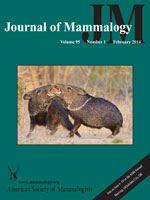White-footed mouse (Peromyscus leucopus) consumption of plant fruits can significantly affect vegetative community structure. However, little is known about the effects of relative selection between different fruit species on the establishment and spread of invasive shrubs. Depending on foraging activity, white-footed mice may provide resistance against exotic establishment, have no impact, or even contribute to invasive spread. Selection of invasive Morrow's honeysuckle (Lonicera morrowii) and 5 native soft-mast species was studied across 3 cover types (forest, field, and edge) and 2 seasons in southwestern Pennsylvania. Foraging stations, containing equal quantities of each species, were randomly placed in each of the cover types. In addition, nutrient composition and total energy were measured. Fruit consumption was nonrandom based on compositional analysis (P < 0.05). Honeysuckle was consumed over native staghorn sumac (Rhus typhina); otherwise, it was consumed less than all natives. Honeysuckle fruits had significantly less lipids (0.67%) than all natives (P < 0.05), and one of the lowest protein contents (0.66%). Total energy was important in distinguishing the highest selected fruits: black cherry (Prunus serotina; 0.45 kcal) and common dewberry (Rubus flagellaris; 0.36 kcal). Selection of high-nutrient native fruits over those of honeysuckle may confer additional competitive advantages to the seeds of this invasive shrub. In this way, white-footed mice may contribute to the establishment of Morrow's honeysuckle in multiple cover types.
How to translate text using browser tools
1 February 2014
White-footed mice ( Peromyscus leucopus) select fruits of native species over invasive honeysuckle fruits
Charneé L. Rose,
Philip J. Turk,
Stephen M. Selego,
James T. Anderson
ACCESS THE FULL ARTICLE

Journal of Mammalogy
Vol. 95 • No. 1
February 2014
Vol. 95 • No. 1
February 2014
diet selection
foraging preference
invasive species
soft mast




